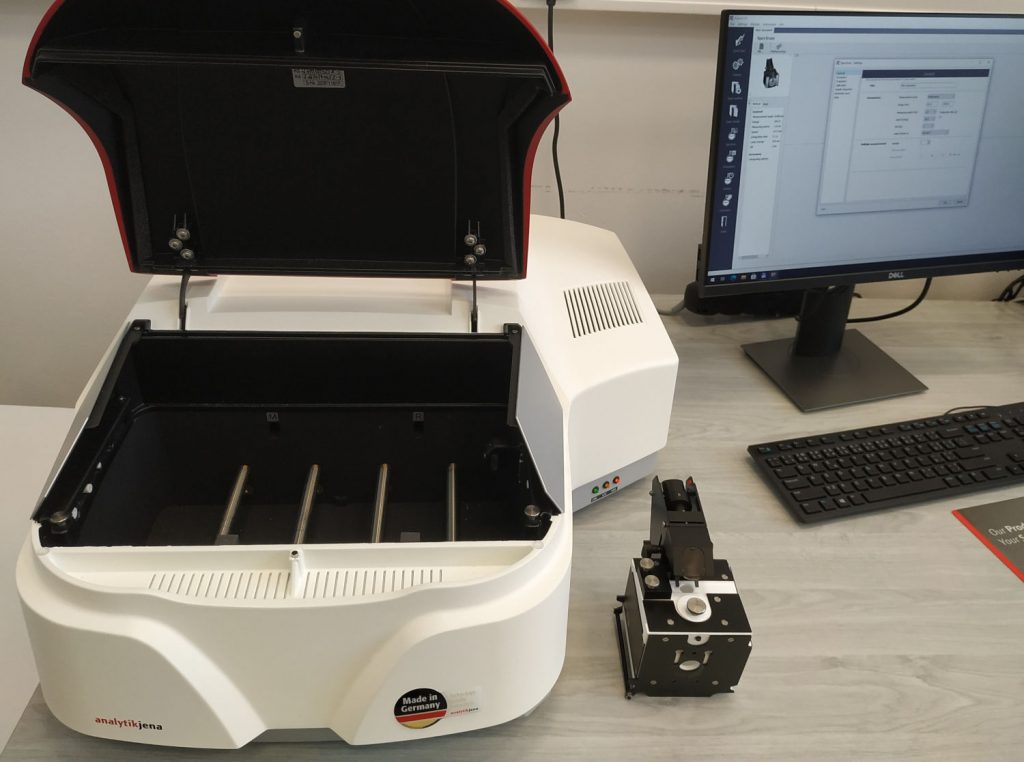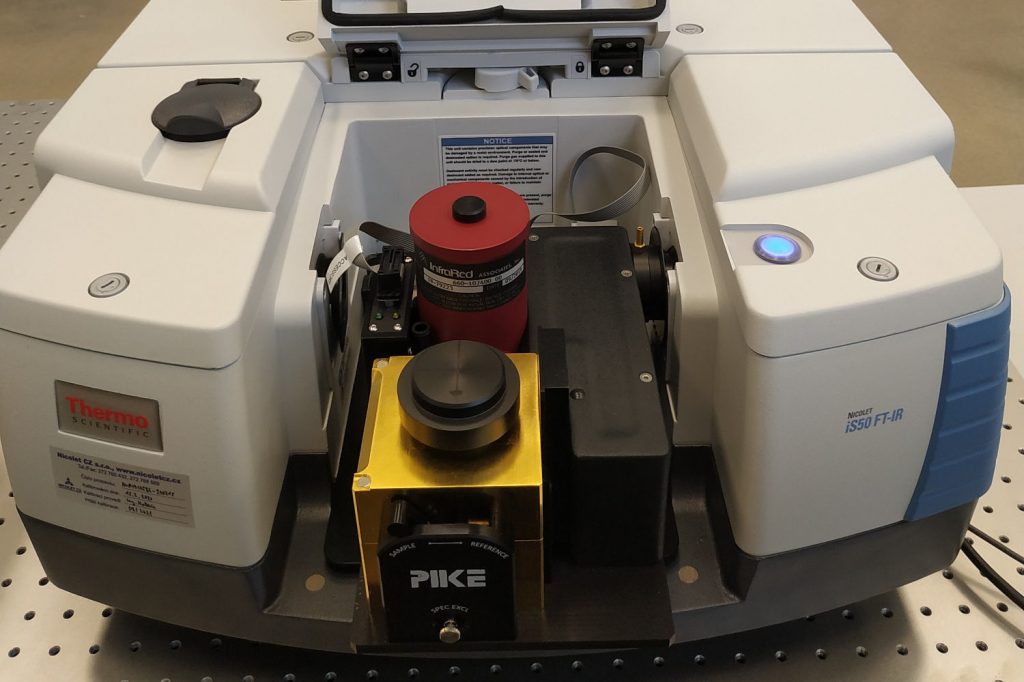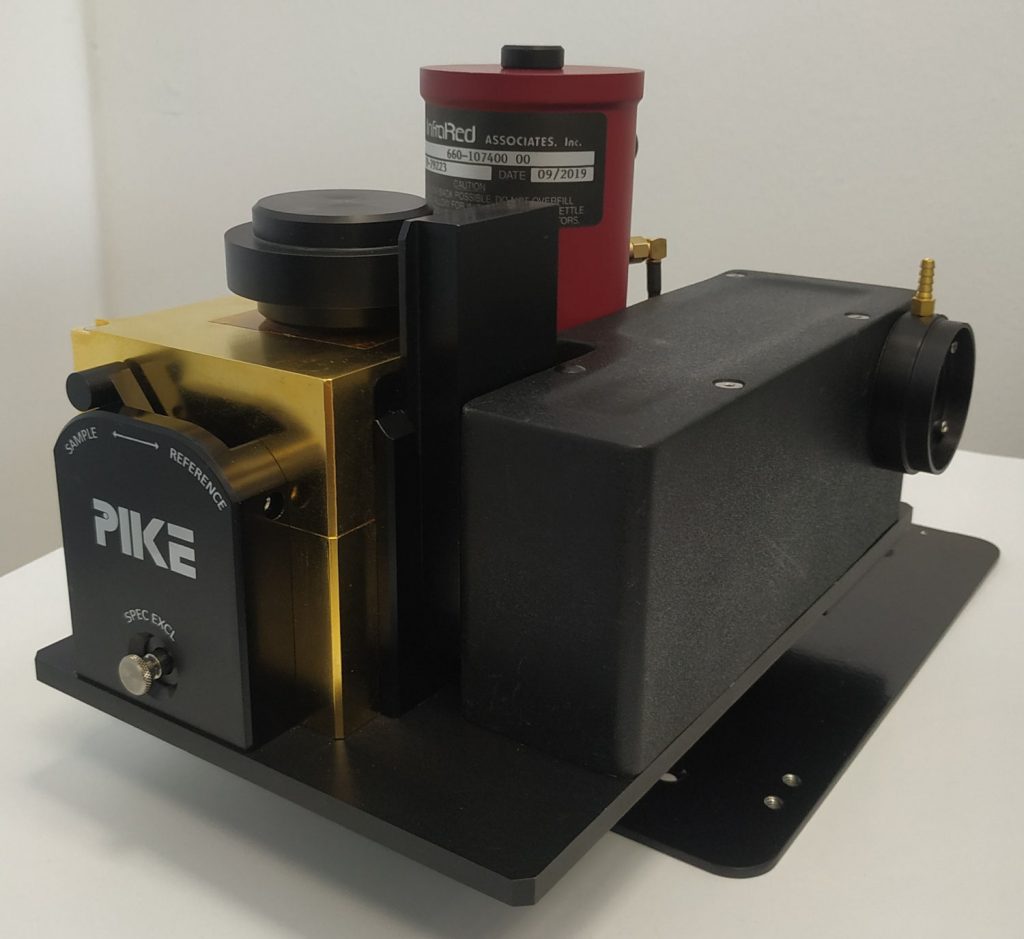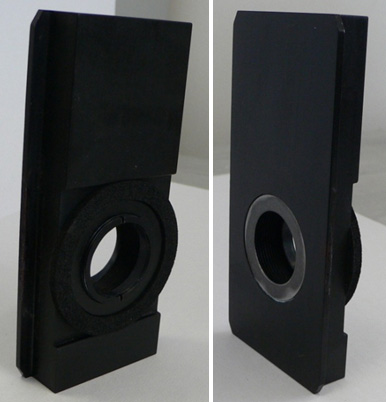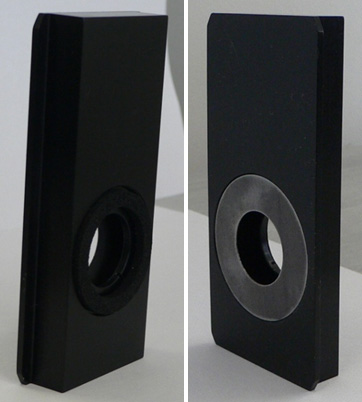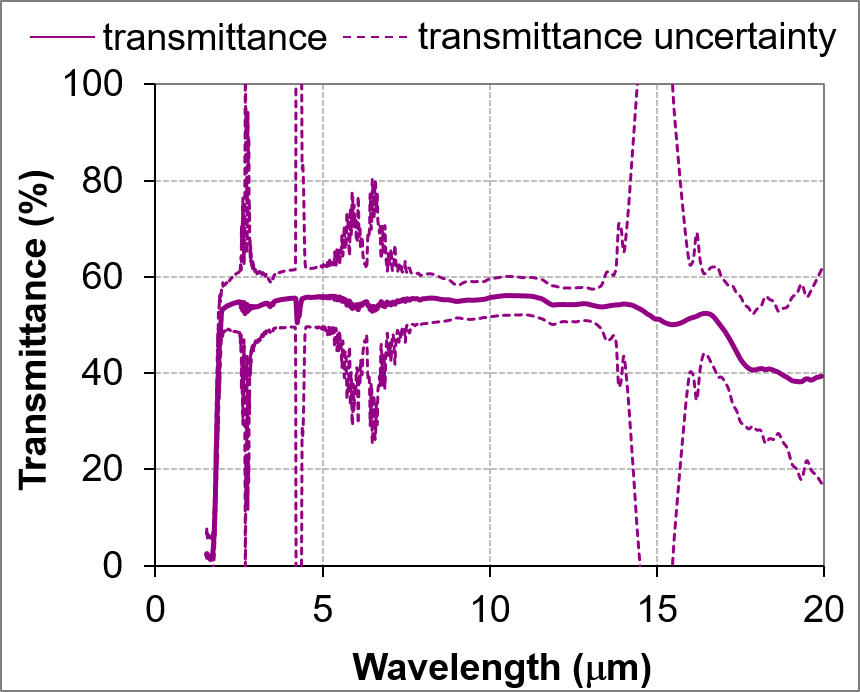SNHTRT
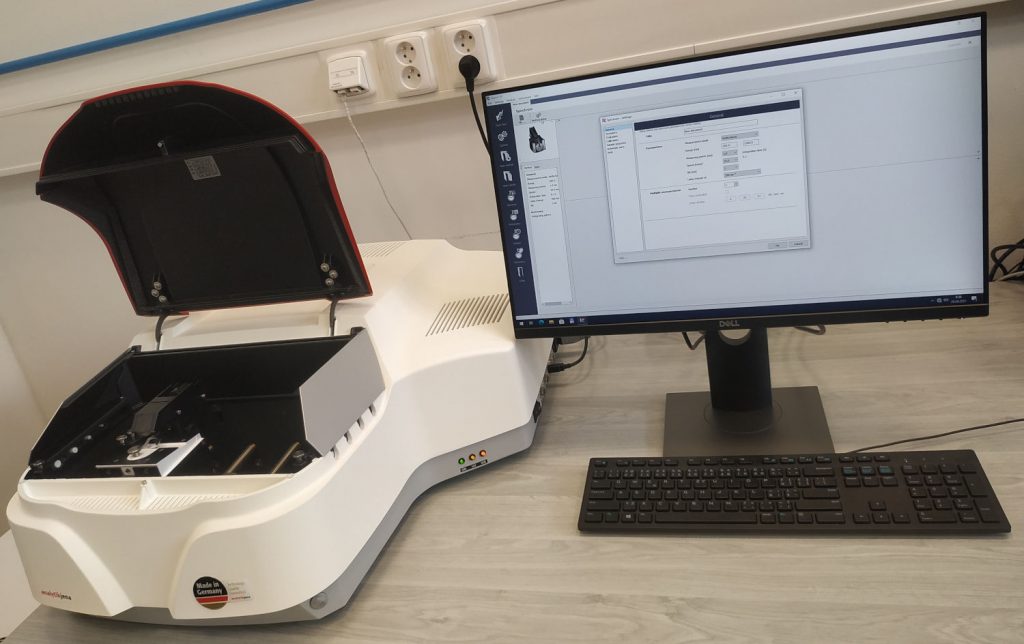
Method for spectral normal hemispherical transmittance measurement in visible and infrared spectral range at room temperature.
The basic parts of the experimental setup are a spectrofotometer and an integrating sphere accessory. The method enables to analyze both semitransparent bulk materials and coatings deposited on semitransparent substrates at room temperature and in the spectral range of 0.32 – 20 um. Spectral normal absorptivity / emissivity of transparent materials can be evaluated in combination with the SNHRRT method.
Measurement system
Components of the measurement system
UV-VIS-NIR spectral range
- Dispersive spectrofotometer Specord 210 Plus
- Integrating sphere accessory with angle of incidence of 8°
- Spectralon diffuse reflectance standard
MIR spectral range
- Nicolet iS50 FTIR spectrometer
- Integrating sphere accessory with angle of incidence of 0°
- Gold diffuse reflectance standard or Molybdenum specular reflectance standard
Description of the measurement system
UV-VIS-NIR spectral range
Radiation from the internal source of the spectrofometer is incident on a semitransparent sample placed on the transmittance measurement accessory – integrating sphere. Specularly or diffusely transmitted radiation is incident into the integrating sphere and on the diffuse reflectance standard located at the bottom of the sphere from where is further reflected in the integration sphere. The inner surface of the integrating sphere is made of highly-reflective Spectralon material, which ensures reflection (scattering) of the incident radiation in all directions, i.e. to the entire hemisphere. Radiation transmitted by the sample is repeatedly reflected inside the integrating sphere until it leaks through the detector port onto the detector. Specular reflectance standard is used instead of diffuse reflectance standard in case of analysis of the proportion of specular and diffuse components of transmittance.
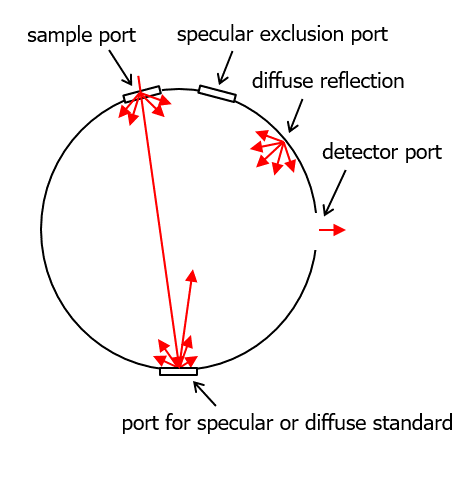
MIR spectral range
Radiation from the internal source of the spectrometer is incident on a semitransparent sample placed in the sample holder which is inserted into the sample port of the integrating sphere. Specularly or diffusely transmitted radiation is incident on a rotary mirror that reflects it to diffuse reflectance standard placed on the integrating sphere. From the surface of the standard the radiation is reflected into the integration sphere. The inner surface of the integrating sphere is provided with a highly-reflective gold coating, which ensures reflection (scattering) of the incident radiation in all directions, i.e. to the entire hemisphere. The radiation transmitted through the sample and reflected from the surface of the standard is repeatedly reflected inside the integrating sphere until it leaks through the detector port onto the detector. Specular reflectance standard is used instead of diffuse reflectance standard in case of analysis of the proportion of specular and diffuse components of transmittance. The advantage of the integrating sphere is the collection of radiation transmitted into all directions, which allows determination of the absolute value of the transmittance for a general sample (any surface roughness and volume scatter).
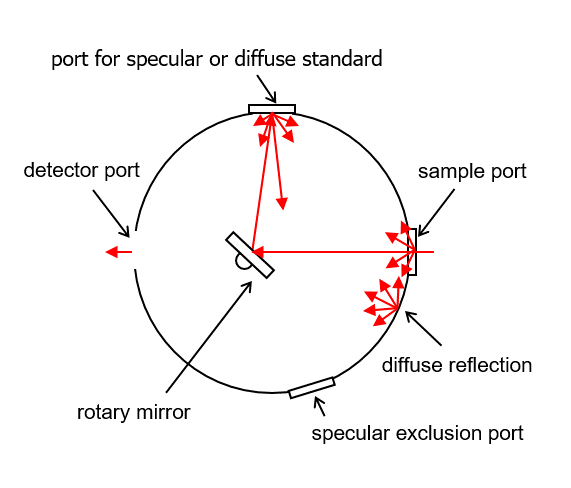
Arrangement options
Specification
Wavelength range
UV-VIS-NIR spectral range
- 0.32 – 1.2 μm
MIR spectral range
- 1.5 – 20 μm
Measured quantities
UV-VIS-NIR spectral range
- Spectral normal hemispherical transmittance
- Proportion of specular and diffuse components of transmittance
MIR spectral range
- Spectral normal hemispherical transmittance
- Proportion of specular and diffuse components of transmittance
Computed quantities
UV-VIS-NIR spectral range
- Band normal hemispherical transmittance
- Solar normal hemispherical transmittance
MIR spectral range
- Band normal hemispherical transmittance
- Integrated normal hemispherical transmittance
Computed quantities by using in addition SNHRRT method
UV-VIS-NIR spectral range
- Spectral normal absorptivity
- Band normal absorptivity
- Solar normal absorptivity
- Spectral hemispherical absorptivity
- Band hemispherical absorptivity
- Solar hemispherical absorptivity
MIR spectral range
- Spectral normal emissivity
- Band normal emissivity
- Total normal emissivity
- Spectral hemispherical emissivity
- Band hemispherical emissivity
- Total hemispherical emissivity
- Spectral normal absorptivity
- Band normal absorptivity
- Integrated normal absorptivity
- Spectral hemispherical absorptivity
- Band hemispherical absorptivity
- Integrated hemispherical absorptivity
samples
Analyzed materials
Semitransparent samples with random and periodic surface structure:
- Semitransparent coatings on a semitransparent bulk substrate
- Semitransparent bulk ceramics
- Semitransparent plastics
- Glass (only for wavelengths below 3 um)
- Optical windows, filters
- Optical lens with a focal distance greater than 100 mm
Dimensions and shapes of samples
UV-VIS-NIR spectral range
- Samples in a form of a block with a width of exactly 9.5 mm, a length of 10 – 50 mm and a thickness of 0.01 – 8.5 mm
- Maximum sample weight 0.5 kg

MIR spectral range
| A1 | Circular planar samples with a diameter of 35 – 45 mm and a thickness up to 0.05 mm |
| A2 | Square planar samples with edge of 35 – 45 mm and thickness up to 0.05 mm |
| B1 | Circular planar samples with a diameter of 25 ± 1 mm and a thickness of 0.01 – 7 mm |
| B2 | Circular planar samples with a diameter of 24 – 38 mm and a thickness of 0.01 – 6.5 mm |
| B3 | Square planar samples with edge of 25.5 ± 1 mm and a thickness of 0.01 – 6.5 mm |
Maximum sample weight 0.5 kg
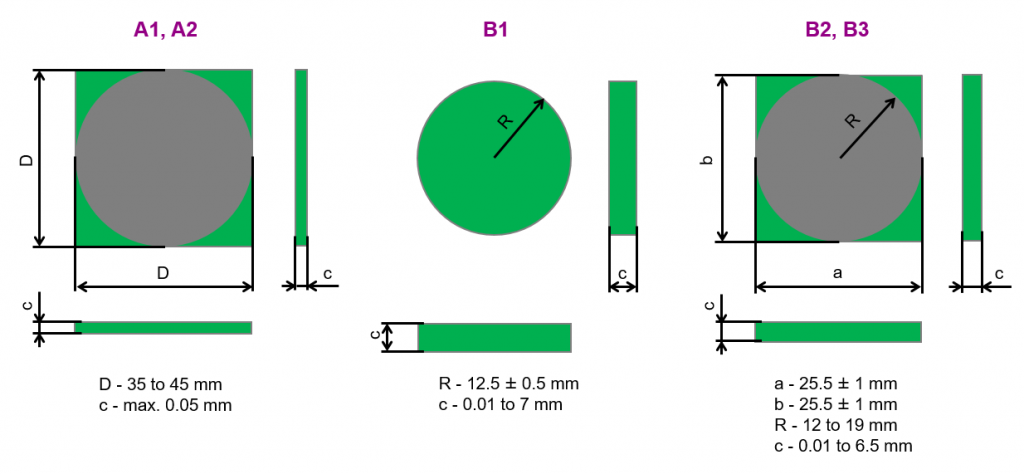
results
- Spectral analyzed quantity – graphical display of spectral quantity distribution (separately for each measurement) and data in electronic form
- MIR spectral range – the spectrum is influenced by atmospheric absorption (higher uncertainty) in the bands of 2.5 – 2.95 um, 4.17 – 4.5 um, 4.8 –7.9 um and 13.2 – 17.2 um
Form of the results
Basic
- Measurement protocol in electronic form in PDF format or in printed form – UV-VIS-NIR example, MIR example
- XLSX file that contains a measurement protocol in electronic form and values of the analyze variable (for MIR range including the measurement uncertainty)
Extended
- Technical report in electronic form in PDF format or in printed form; the report contains description of method and measurement procedure, measured samples, summary of results of all measurements, discussion of the results and conclusions of the research
